Five days ago I photographed an entire mating sequence of a pair of Swainson’s Hawks in Beaverhead County, Montana. I’ve photographed mating raptors before but those series of images were short and the vantage point of the viewer was usually from the front or side. This time I got 93 images of the behavior from mostly behind the birds so some of the mating images are a little more clinical and have less eye contact but I think they show an interesting perspective on the behavior.
I wasn’t particularly close to the hawks when it happened but that helped me to get both birds sharp. This is a large post of 15 images so I hope it hasn’t been annoyingly slow for some readers to load.
Techs for most of these images were: 1/1000 to 1/1250, f/6.3, ISO 800, Canon 7D Mark II, Canon EF500mm f/4L IS II USM +1.4 tc, not baited, set up or called in
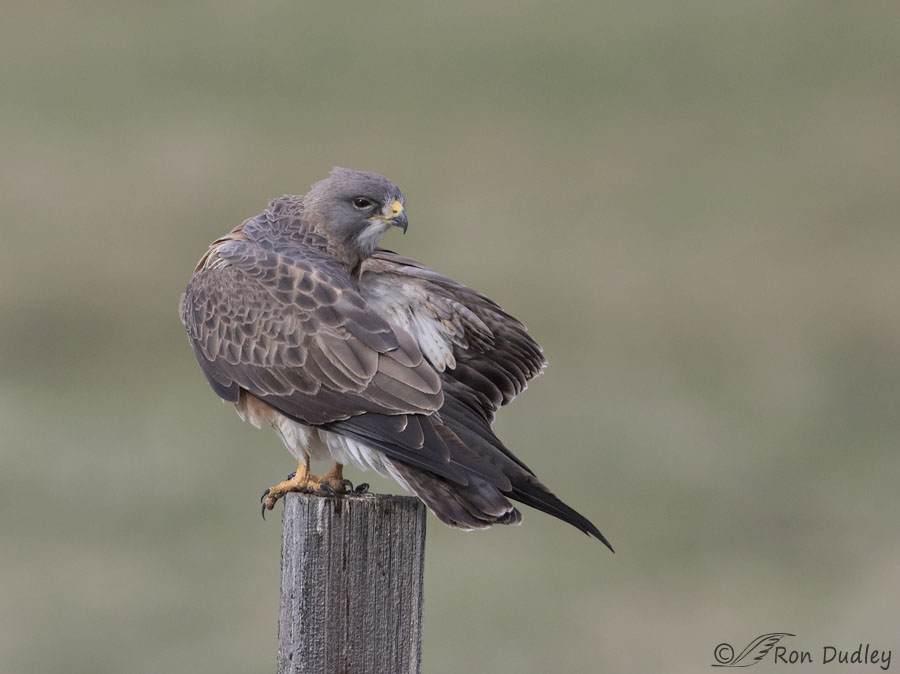
It all began when I was photographing this male Swainson’s Hawk perched on an old fencepost. When he defecated I thought he might be about to take off but instead he began a short preening session…
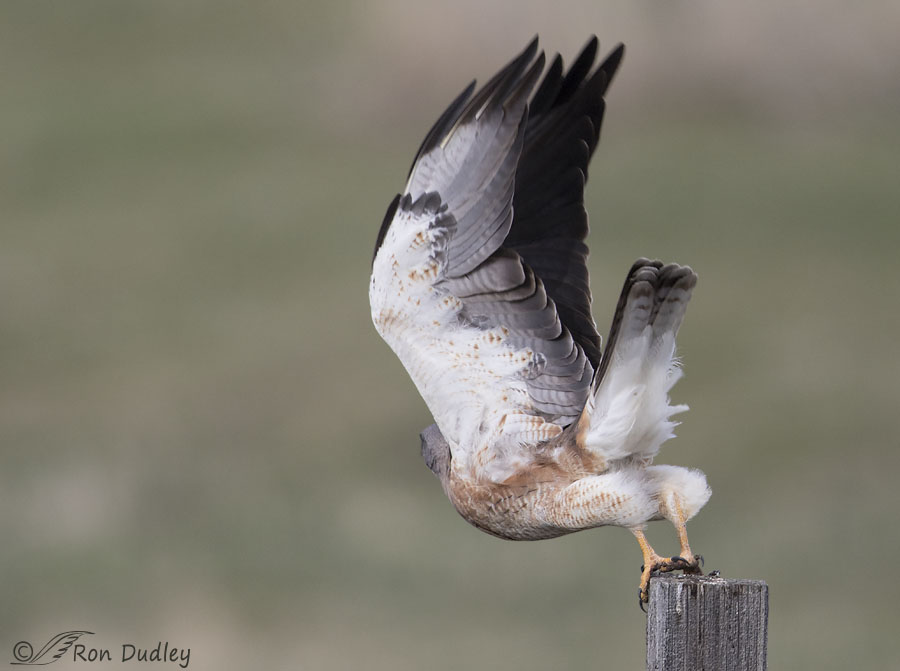
and then abruptly took off. In this situation with his direction of flight being away from me I’d normally drop my lens and watch the bird with my naked eye but for some reason this time I kept him in my viewfinder and suddenly…
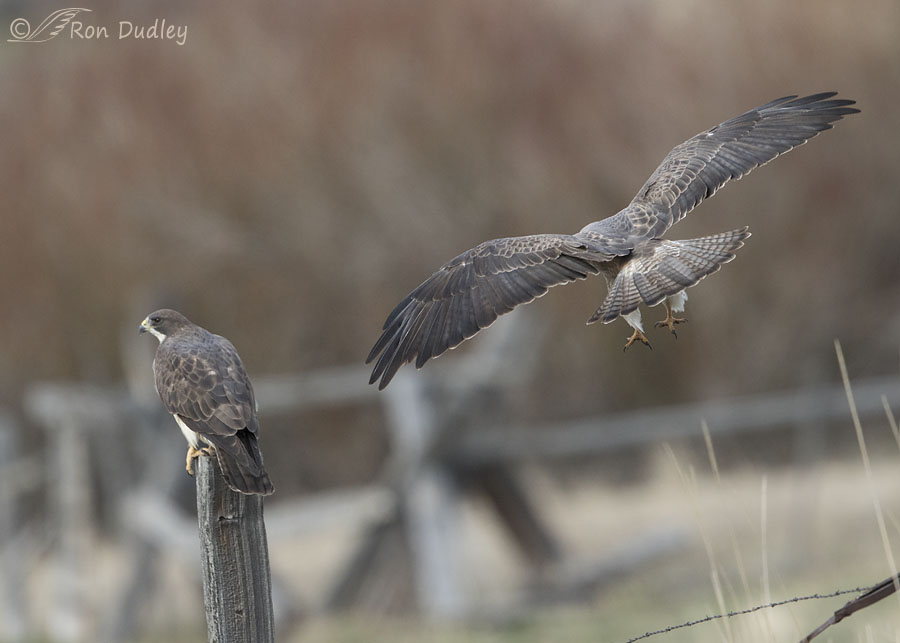
I could see that he was approaching another Swainson’s Hawk on a fencepost down the line, a bird that I didn’t even know was there! At this point I thought the first bird might land near the second or even that there might be a fight so I just kept firing away and hoped I’d capture something interesting.
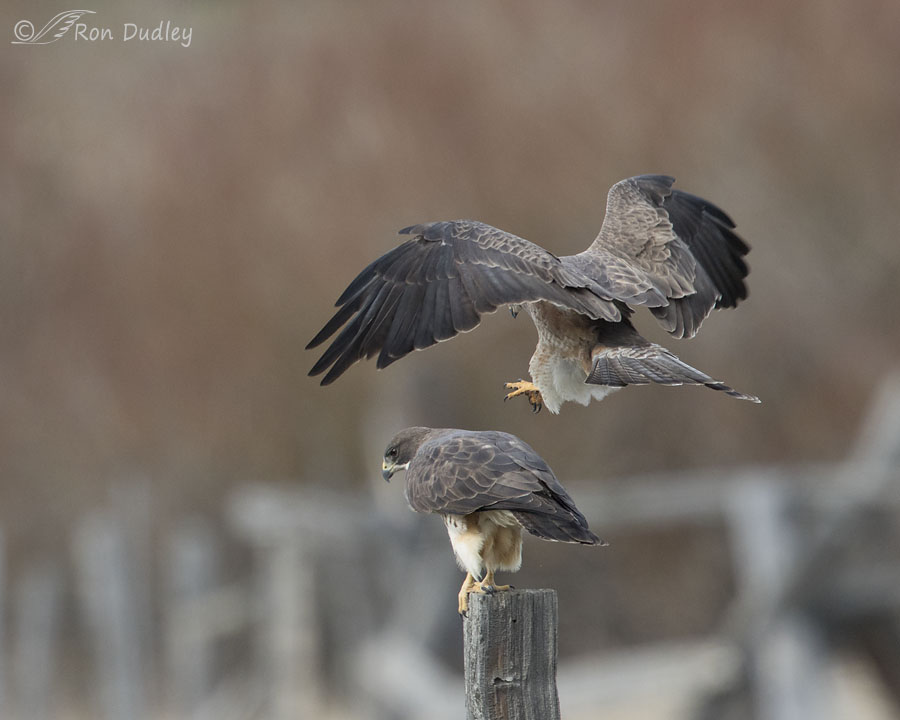
But these birds had mating in mind. In some of the earlier images as the male approached the female she had her head turned toward him and was calling to him but here she had stopped calling and was bracing for him to land on her back.
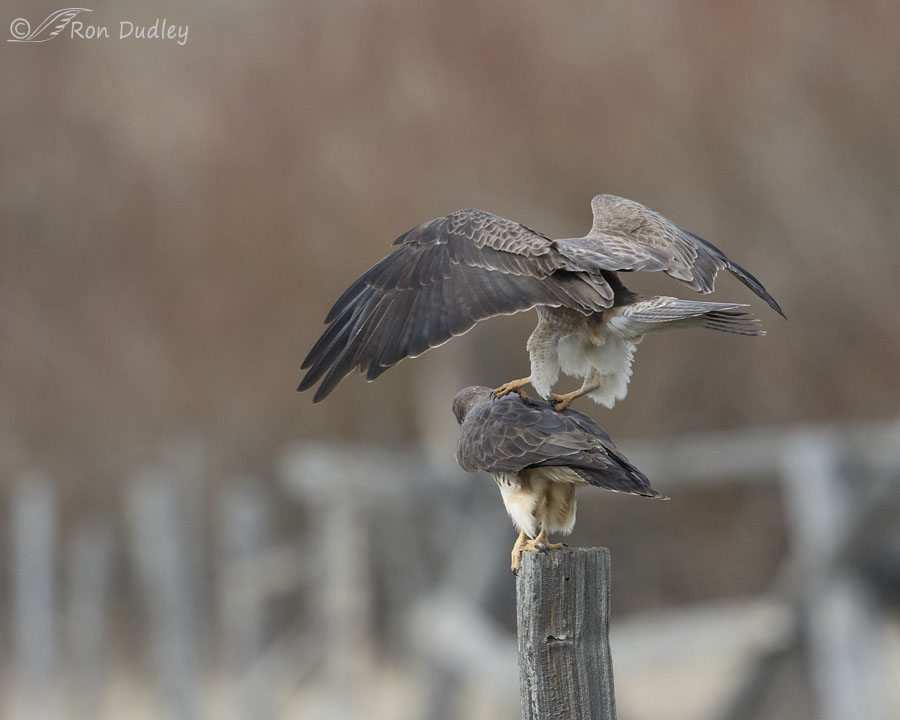
Touch down.
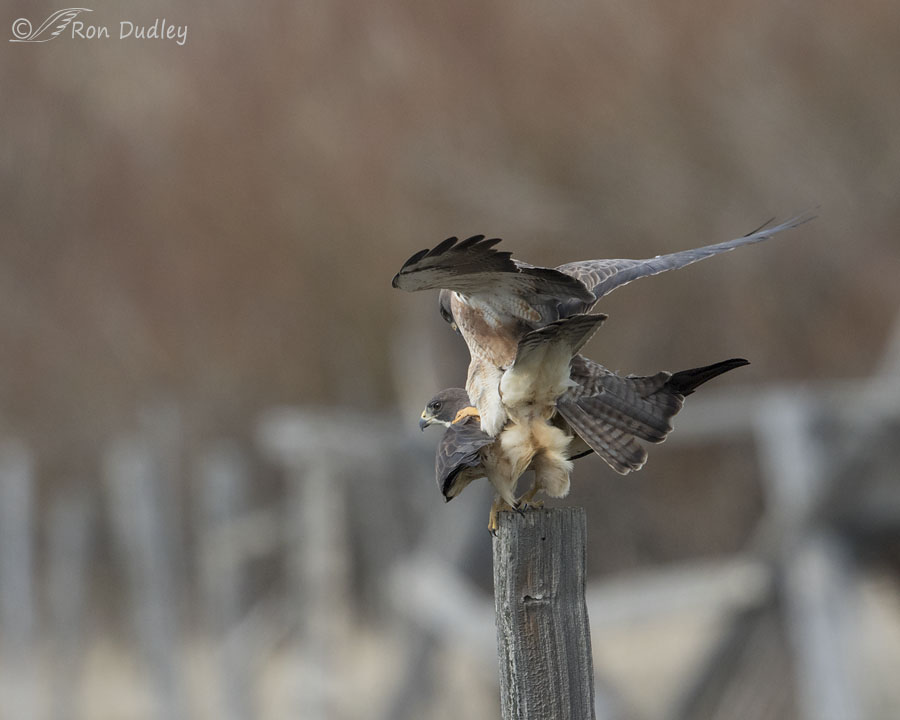
Balance is always precarious for both birds in these situations but especially for the male. Even with her obvious assistance he struggled to stay on her back.
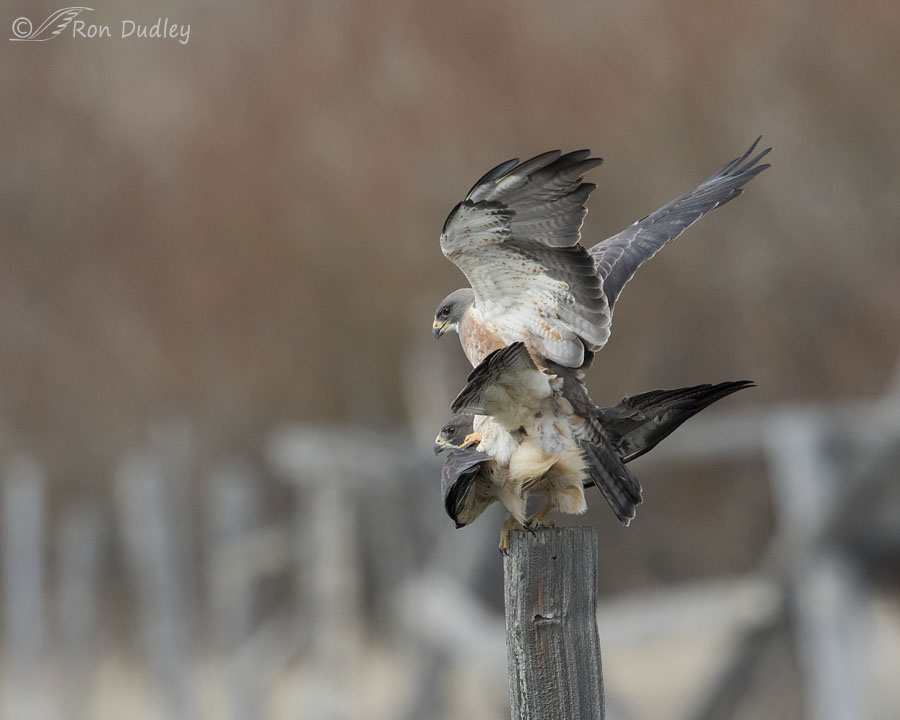
Here she begins to present her cloacal opening as the male gets into position for sperm transfer.
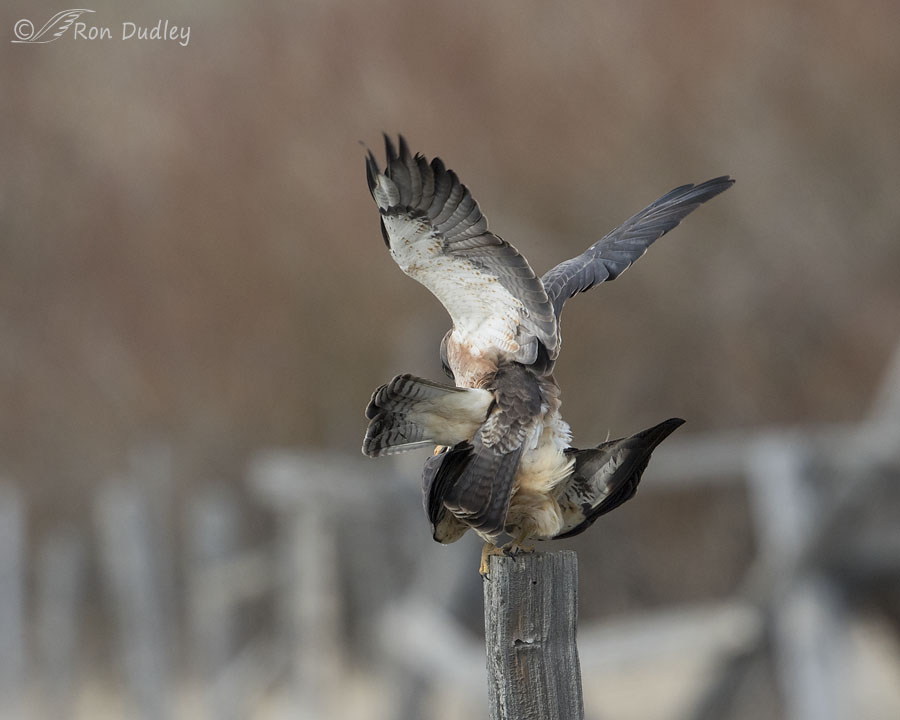
Contact between cloacal openings of male and female birds for sperm transfer is commonly called the “cloacal kiss”.
It’s interesting to note that some male birds (ostriches, cassowaries, kiwi, geese and some swans and ducks) have an intromittent organ (penis) to facilitate sperm transfer and possibly prevent water from washing the sperm away during copulation. Raptors lack such an organ.
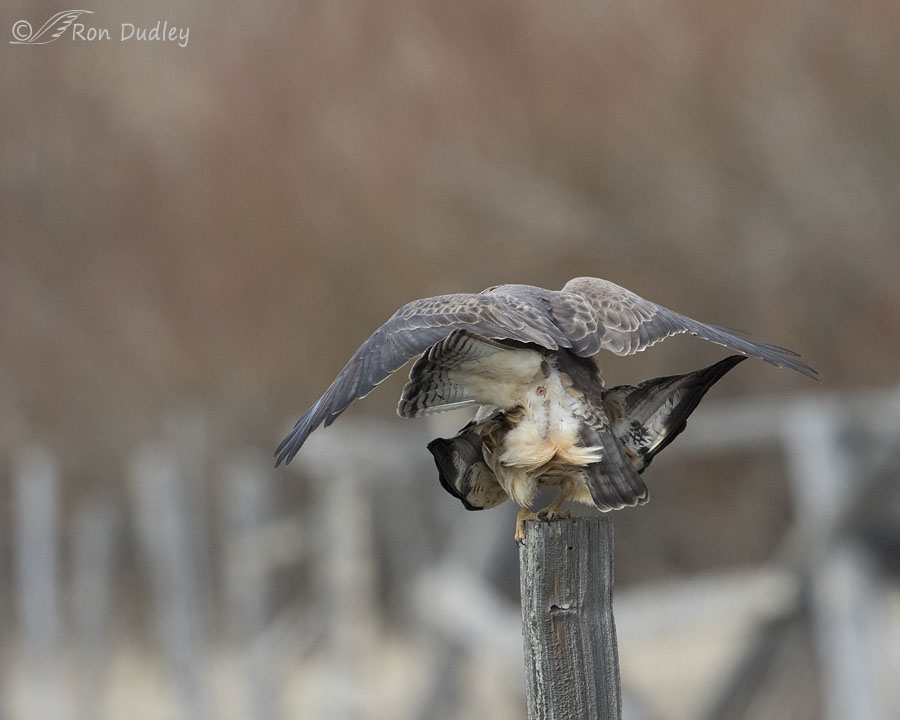
Here we get a good look at the cloacal opening of the female just after the male pulled his tail away. Successful sperm transfer may not have occurred on this first attempt because…
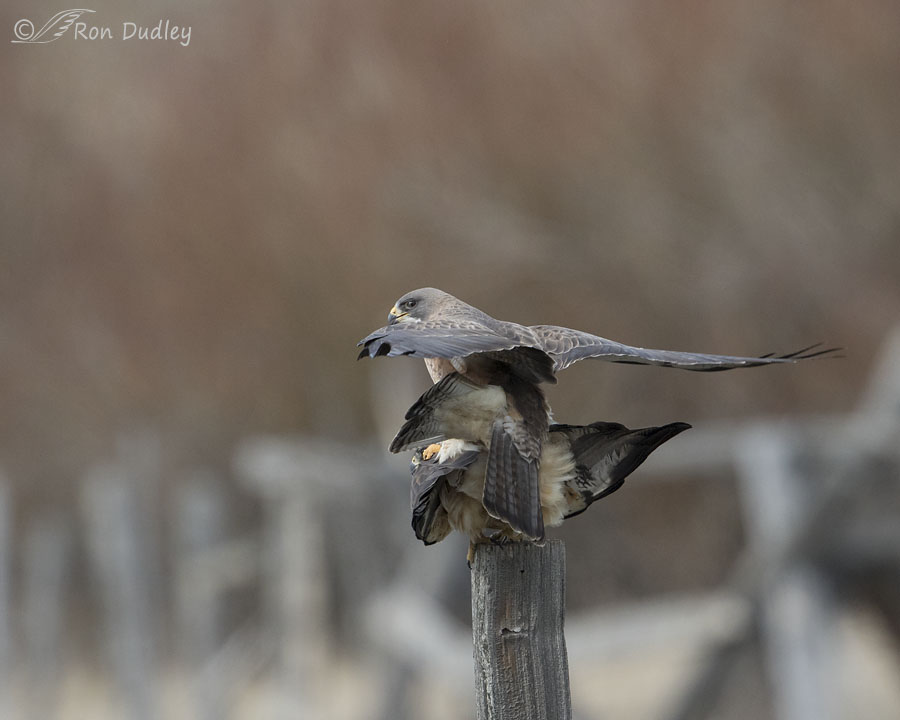
they apparently made cloacal contact…
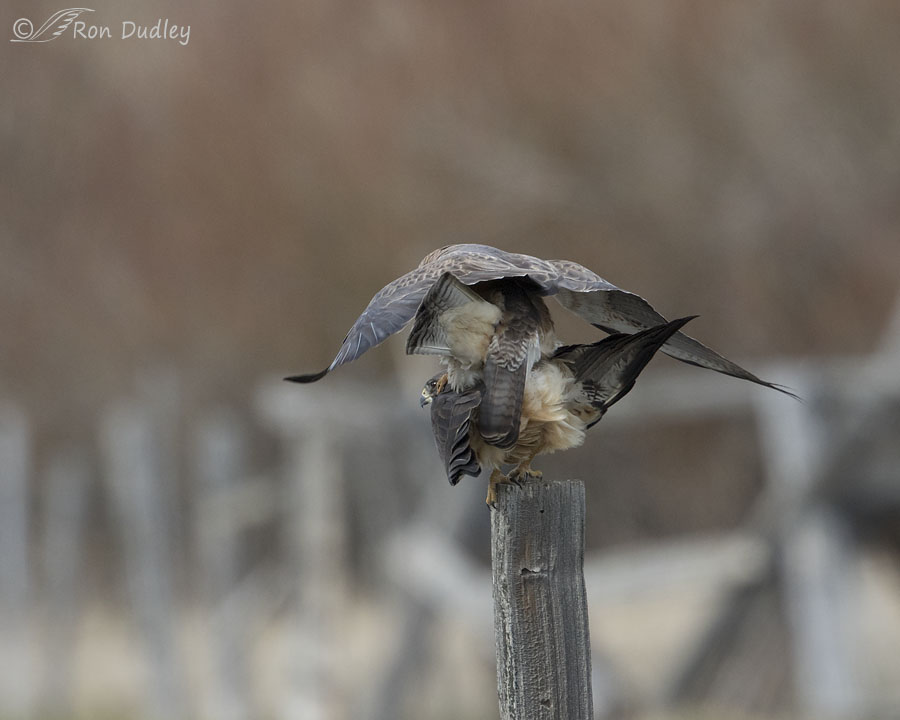
several more times…
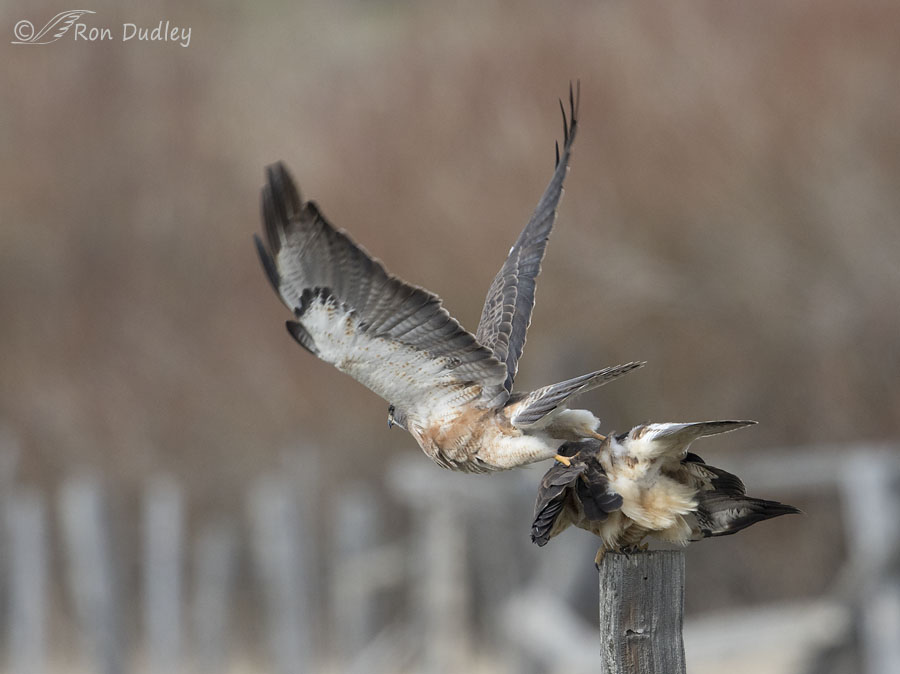
before the male pushed off…
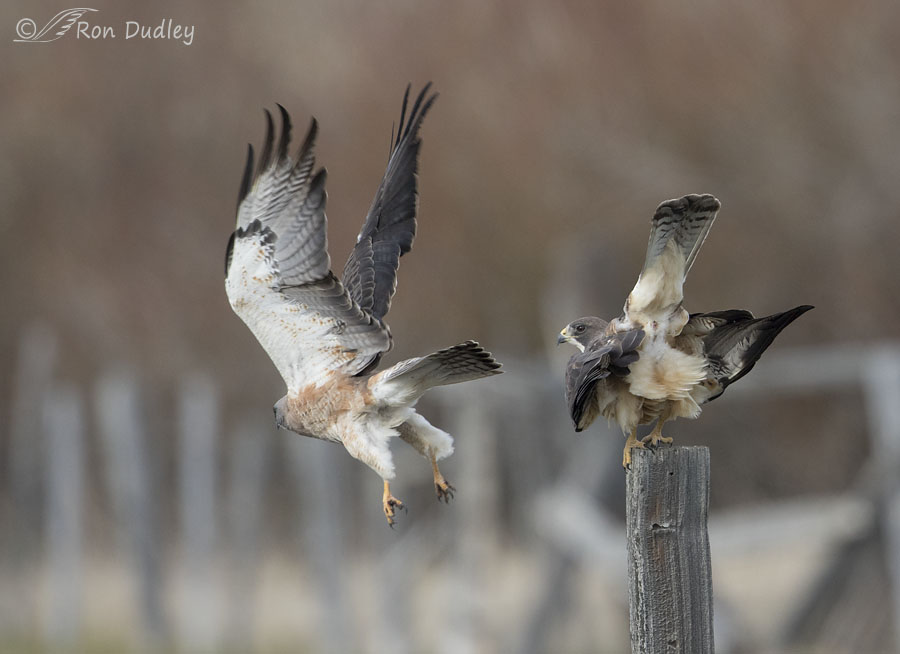
and flew away.
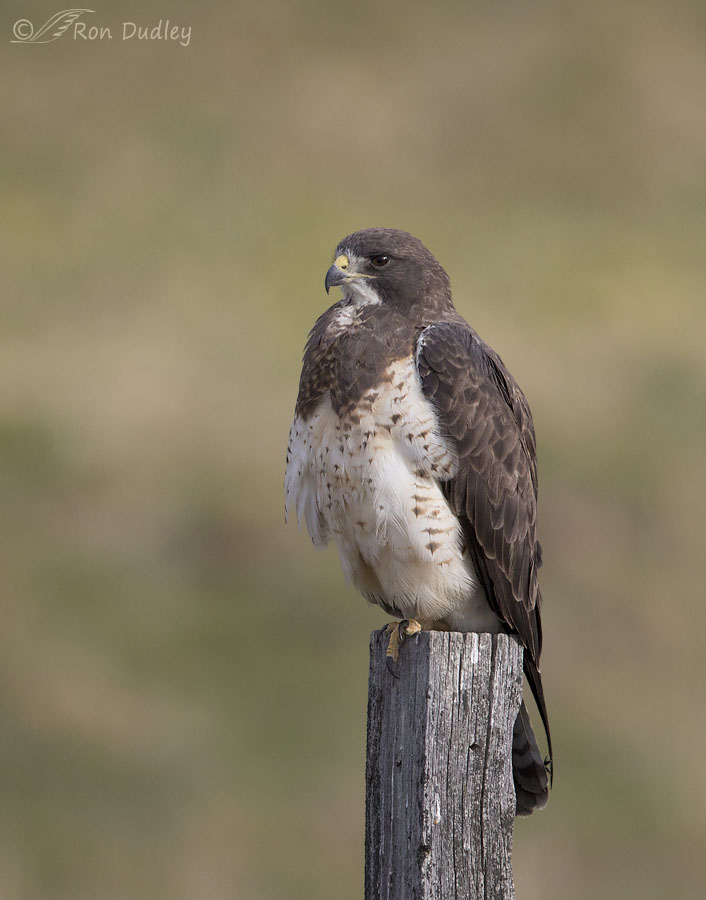
1/2000, f/6.3, ISO 500, Canon 7D Mark II, Canon EF500mm f/4L IS II USM +1.4 tc, not baited, set up or called in
I thought some might appreciate a better look at both birds (both images taken soon after mating). The female is a light morph…
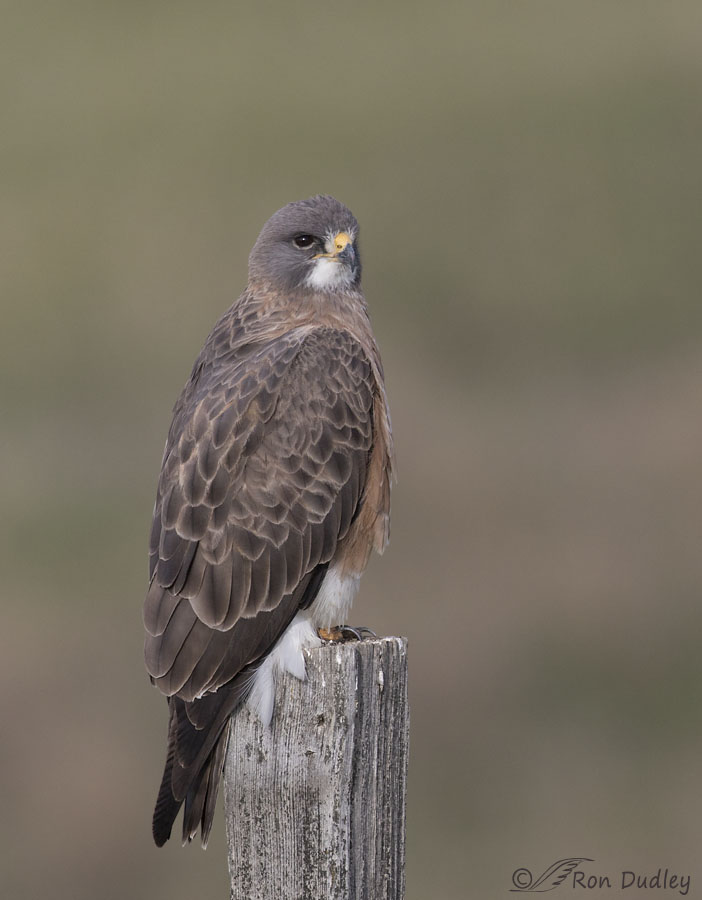
1/1600, f/6.3, ISO 500, Canon 7D Mark II, Canon EF500mm f/4L IS II USM +1.4 tc, not baited, set up or called in
and the male is an intermediate morph (note the extensive rufous color on his breast and belly). I now know where their nest is (I never approach raptor nests but I’ve seen this one far off from the road) and later this summer after the presumed chicks fledge I’ll be interested in seeing what color phase(s) the youngsters turn out to be.
A couple of these images may be a little too clinical for some and if so I apologize. But with my biology/zoology background and deep interest in bird behavior this series of images is right up my alley.
Ron


I like the picture after he has flown away. She is just sitting there and looks crabby.
Wait a minute! Are you telling us tha the stork doesn’t bring those baby hawks!!!????
So THAT’S how it’s done! Simply amazing…and though I haven’t commented here in many weeks, it’s not for lack of interest in your daily reports, which I read and so enjoy. But this series requires special thanks for showing raptor behavior that I’ve certainly never seen so up close & personal before, truly educational. And these Swainson’s Hawks are just gorgeous. Yes, let’s hope for many gorgeous hawklets to come! Thank you, Mr. Dudley.
Simply amazing…and though I haven’t commented here in many weeks, it’s not for lack of interest in your daily reports, which I read and so enjoy. But this series requires special thanks for showing raptor behavior that I’ve certainly never seen so up close & personal before, truly educational. And these Swainson’s Hawks are just gorgeous. Yes, let’s hope for many gorgeous hawklets to come! Thank you, Mr. Dudley.
No apologies necessary, what a great show they put on. Never seen anything even close to that so thank you, it was very educational.
Add me to the chorus of Wows, who are wishing that several more Swainson’s Hawks are added to the breed.
Me too, EC. I’ll be watching that nest (from afar) later this summer and I’m sure I’ll report back here on developments.
the additional information you present with your photos is fantastic.
don’t ever think it is ‘too much’. you are a teacher through and
through, which is a beautiful thing, and never needs an apology.
many thanks for the beautiful series of photos….
How nice of you to say, Karen. Reminds me of how lucky I was that I ended up a teacher (a role I adored). My profession could very easily have taken a different turn and I suspect I’d have been miserable in most any other job or profession.
Absolutely superb series of photos documenting mating behavior in raptors. Question, do you think you could use this series of photos to teach a high school biology class in Utah without getting called into the principal’s office?
Unless things have changed since I retired I think I could, Dennis, at least in the district where I used to teach which is more liberal than most in this state (though some very recent developments regarding science curriculum have me very worried for the future of Utah’s school kids.)
youbget some of the most amazing series! Let’s hope the mating was successful, the clutch is large and that they all survive…
They can have as many as 5 eggs in a clutch, Patty (though 2 is typical). Wouldn’t that many youngsters be a welcome addition to the raptor population?
Wow, Ron. This was fabulous and I agree with Nancy. Felt like I was shoulder to shoulder with you and the rest of the regulars.
I enjoyed having you along, Arwen :).
Outstanding series Ron! THANKS!!
Thank you, Laura.
No apologies. A magnificent series of photos. You are a very talented man.
I don’t know about that, Bill but I appreciate the compliment!
Wonderful series of images! The clinical is okay by me. What I find interesting is that in the individual portraits at the end of the post, the male looks much happier than the female. Maybe it’s just her raptor face, but to me she looks downright grumpy.
Susan, since the female of this species has to do virtually all of the incubation maybe her grumpy demeanor is because she’s thinking of all the time she’ll be spending on the nest soon, in all kinds of weather…:)
In ballroom dancing, there is a general rule “leaders left, followers right” so partners know which foot starts. That way people can dance with any partner without stepping on each other. I’m really curious if birds have a similar convention about tail placement. Humm…..more research needed here. Thank you for the peep, Ron!
Interesting thought, Mikal. I’ve documented left “handed” owls in the past so maybe this is something I’ll be keeping my eye out for…
Ron, No need to apologize for photographing the beautiful and natural behavior of these gorgeous birds! It’s what animals do and without their considered effort we wouldn’t have chicks this year :>)
A most beautiful series to help broaden my understanding of their behavior, and I’ll take your regard for their privacy as another measure of your ethics towards these creatures.
Loved the series!
I agree with you completely, Alan but I know from experience that some folks would rather not see the “gory details” of how those beautiful birds come to be. A matter of taste I guess…
Hi Ron,
Wonderful, as always. I have witnessed Swainson’s Hawks copulating, but NOTHING like this!
I am not a photographer (as you know), so it has always been an experience of “knowing” what
went on, but not being able to actually “see” it. Your sequence helps me “see what I didn’t see”.
I could go on, but I hope you get the picture. Having said that, I think you always “get the picture”!
Cheers,
Dick
I know what you mean, Dick – witnessing something is wonderful but to have the additional resource of photos that can be reviewed and analyzed is definitely a bonus, especially for folks like you and me.
Such a learning experience. I would never the opportunity to witness this in person. So the Bird Master takes me there with such amazing photos. Thanks again Ron.
I’m not the “master” of anything, Ellen – birds in particular, but I do work on it. Thanks.
Ron, this series on the Swainson’s Hawk mating just blew me away. I’ve been very involved in following 3 eagle cams & have had a chance to see some mating but your photos are a wonderful education on the whole process. These hawks are beautiful raptors too. Hope you don’t mind but I shared your website address with my eagle buddies. I know they will love this series & I’m sure some will sign up for your daily blog. The more people you not only amaze but educate as with you photos, it will increase the number of people who will work to protect our beautiful wildlife. I bet you never realized you would continue to educate people after retiring!!!
I don’t mind you sharing the link at all, Jo Ann, I welcome it. Thank you.
Being schooled by a master is never “overdoing it” Ron! Your humility, style and dedication to nature never gets old. Wish I had some teachers like you during my formative years. Fortunately for many of us, your passion for nature, photography and teaching burns brightly and enriches us.
Thanks! Great Work.
What a nice thing(s) to say, Neil. Made my day…
Ron, all I have is lots of mating scenes from the mated pair of COHAs close to our house. The male always looks unbalanced. He iis quite small and she is very large. Your shots are amazing. Easy to see how the female has to help by presenting her cloaca. What beautiful birds. Hope for a healthy clutch. Glad you always mention how respectful you are to the birds. I know everyone reading your blog feels the same but it is good to mention it so anyone who reads can learn how important it is to respect wild animals and their habitats. Thanks so much.
“Glad you always mention how respectful you are to the birds”.
I always try to work that in without sounding sanctimonious about it, Diana – especially when raptors are involved. Newbie photographers in particular see images like some of mine and make incorrect assumptions about how I got the shots and what are (or should be) acceptable field ethics.
Excellent series Ron! Greatly appreciate your knowledge and meld of information!
Thank you, Dick.
Ron… What an amazing series . Thank you for sharing this and as always I get to learn something new from you about birds, “Post-coital”. Thank you once again!!!
I’m glad you liked the series, Butch. Thank you.
What an amazing series Ron! Without your observation and talented skills, most of us would never be able to see. Thanks so much for sharing!
Charlotte
Thanks very much, Charlotte.
Great sequence Ron. And, I loved the “post-coital” portraits.
“post-coital portraits”
Great name for them, Jeff. Thank you.
I loved seeing this sequence. It is interesting to learn the information you shared and the photographs along with the words were a great teaching tool. Beautiful hawks.
I appreciate the feedback on the “information”, Wendy. I worry about overdoing it sometimes…
Ron – Incredible sequence of photos to show this behavior! I feel like I was there in person witnessing this too! Astounding!
“I feel like I was there in person witnessing this too!”
Good!. From my perspective as a blogger that’s perfect, Nancy. Thank you.